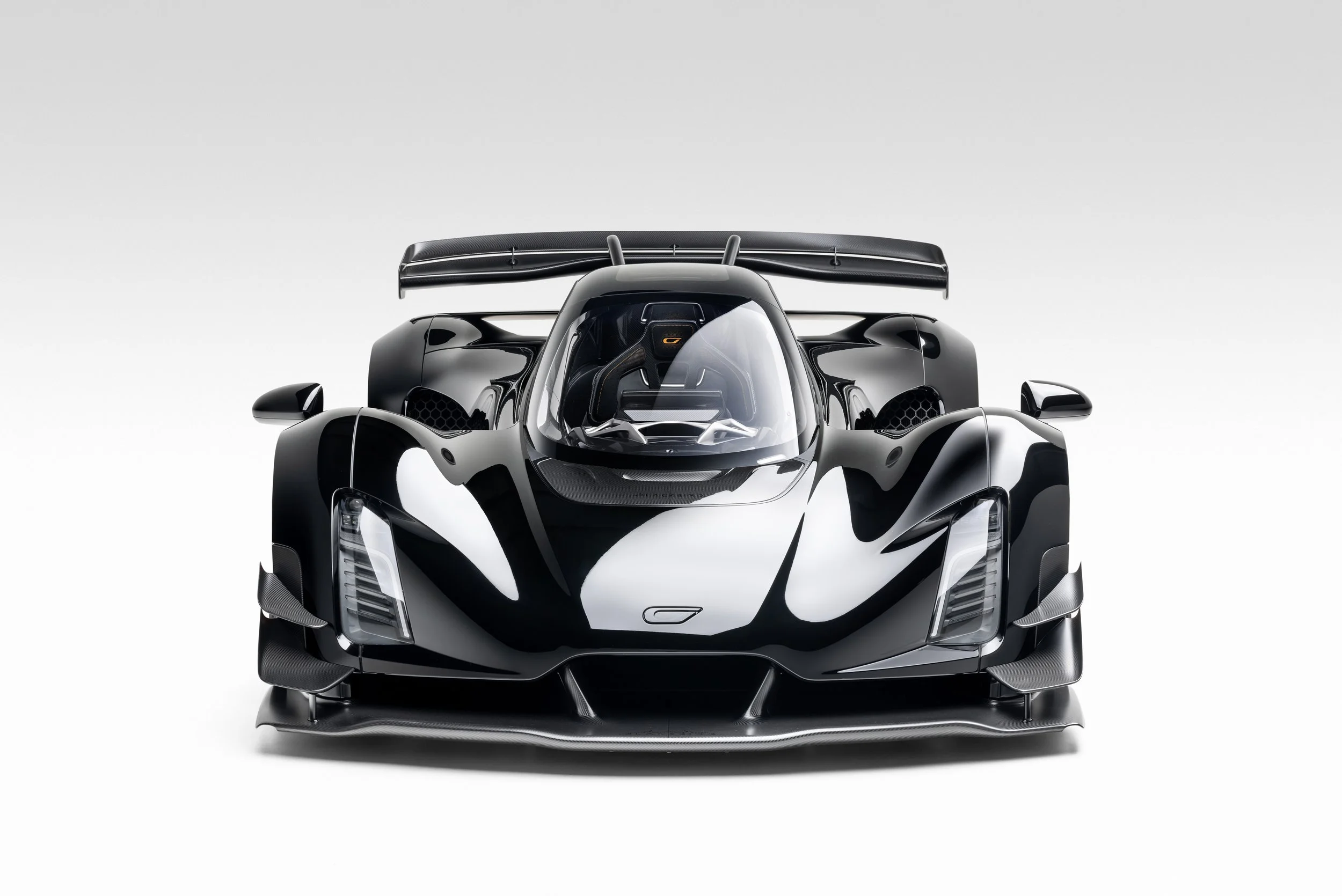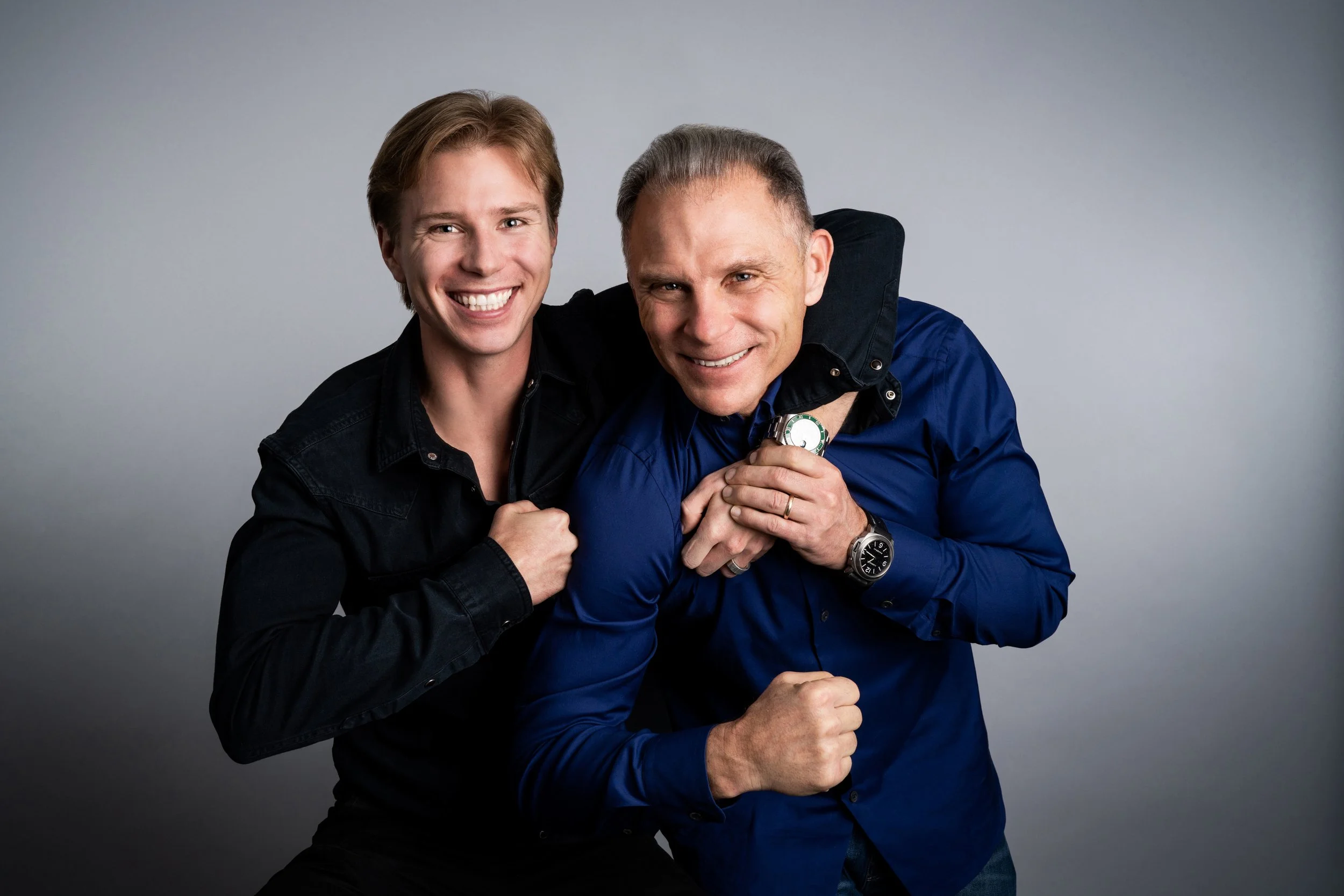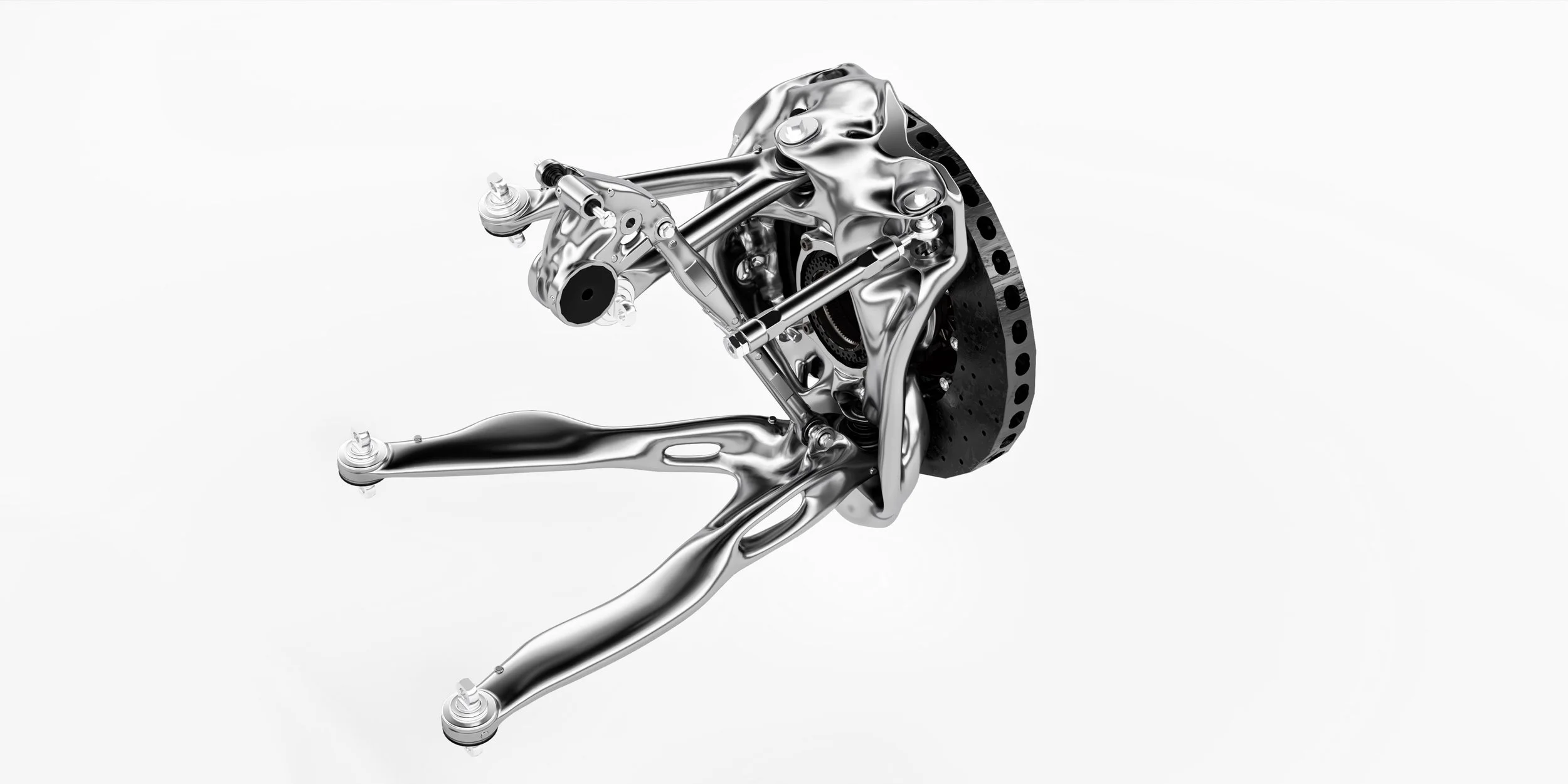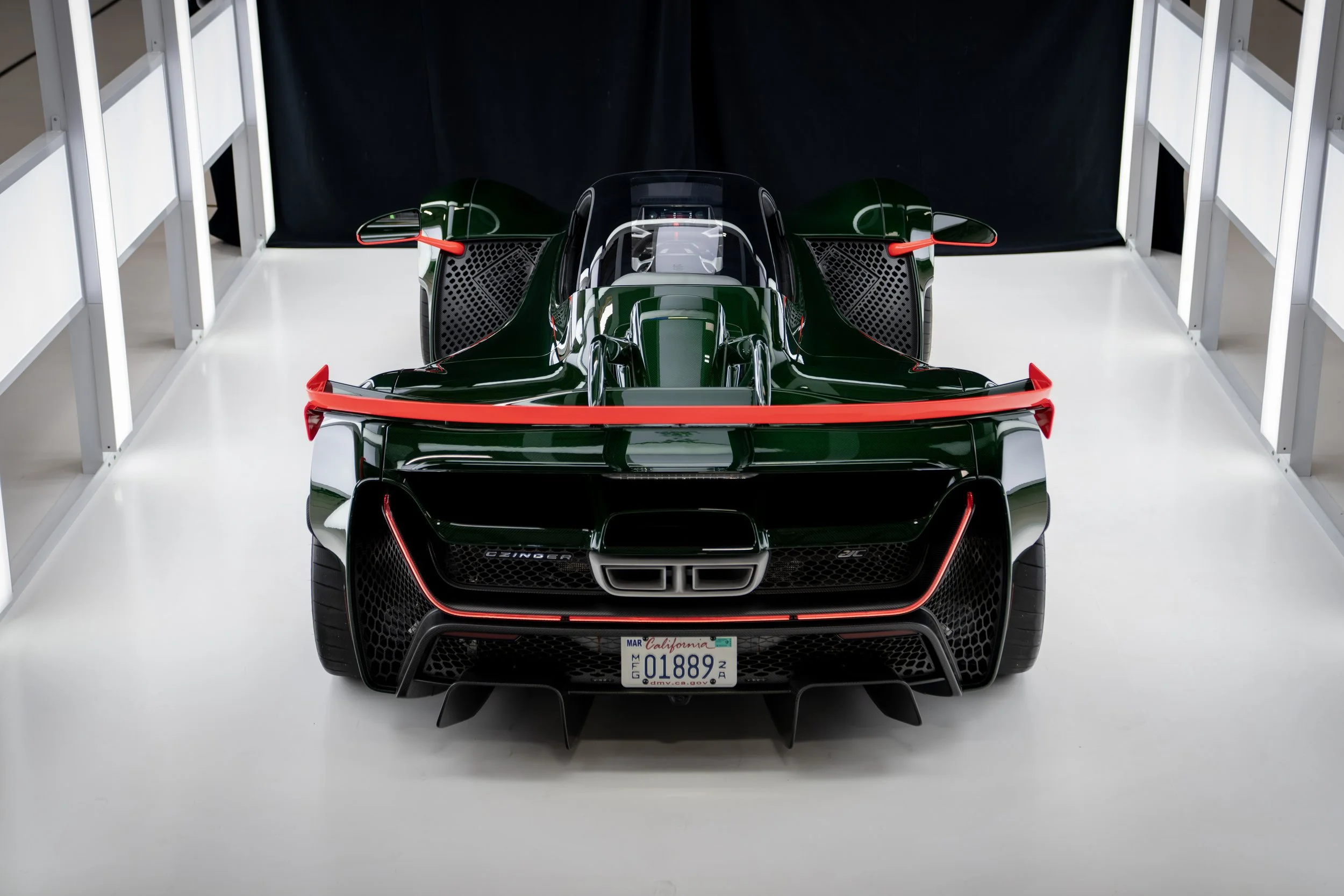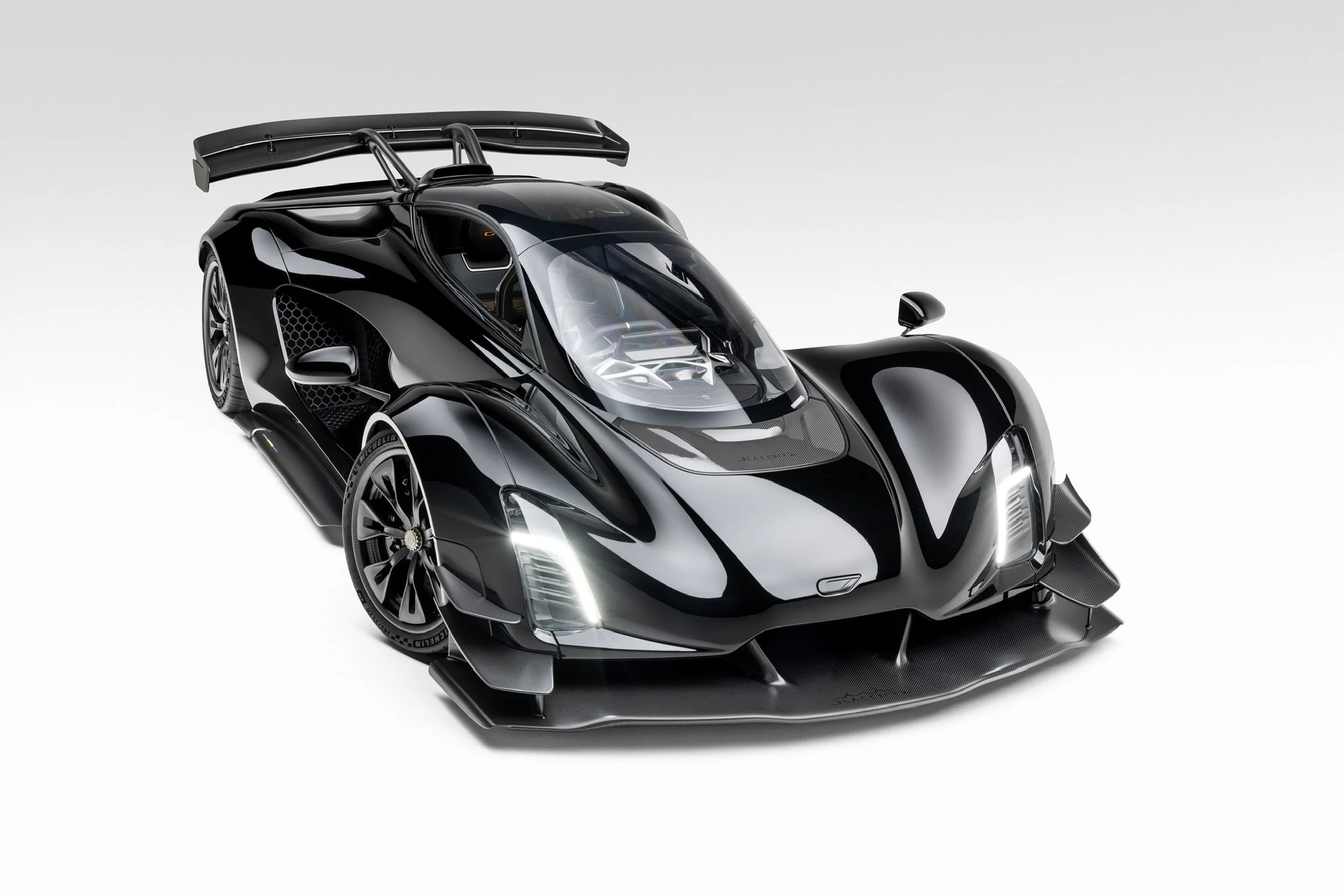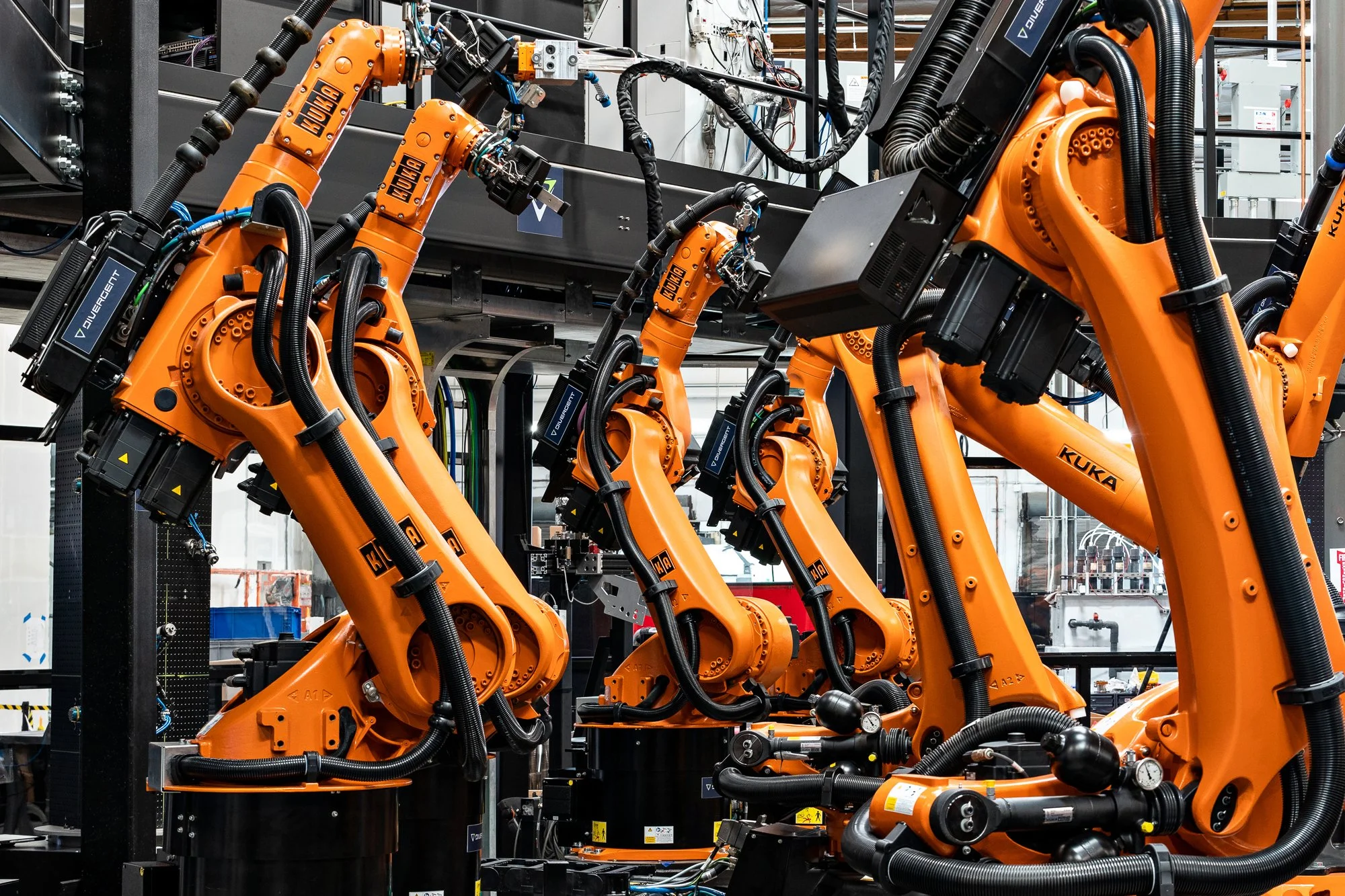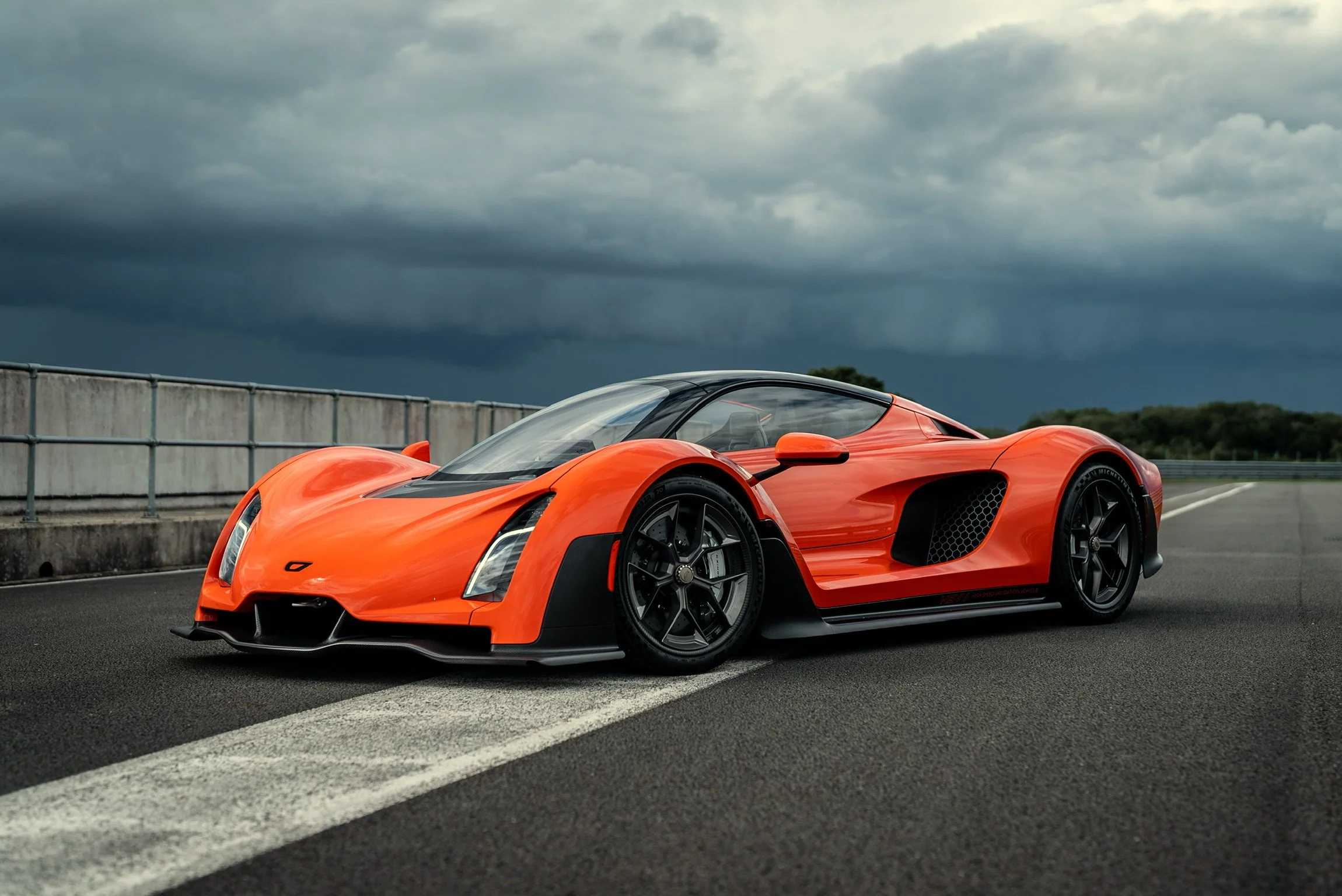Czinger – Die Hypercar-Revolution aus Los Angeles
1. Die neue Ära des Automobilbaus
In einer Welt, in der Hypercars längst zum Statussymbol für Ingenieurskunst, Performance und Luxus avanciert sind, wagt ein junges Unternehmen aus Los Angeles den radikalsten Neuanfang der Branche. Czinger Vehicles ist keine klassische Automarke – es ist ein Manifest. Ein Ausdruck dessen, wie Automobilbau im 21. Jahrhundert gedacht, gestaltet und gebaut werden kann. An der Schnittstelle von künstlicher Intelligenz, 3D-Druck und nachhaltiger Produktion bricht Czinger mit jahrzehntealten Dogmen der Industrie. Und liefert gleichzeitig ein Hypercar, das alles übertrifft, was man bislang aus Europa, Japan oder den USA kannte.
Die Weltpremiere des Czinger 21C im Jahr 2020 schlug hohe Wellen – nicht nur wegen seiner atemberaubenden Zahlen wie 0 auf 100 km/h in 1,9 Sekunden, einem Topspeed von über 400 km/h oder der kompromisslosen Designlinie, die mehr an ein Kampfflugzeug als an ein Straßenfahrzeug erinnert. Was die Fachwelt besonders elektrisierte, war der Weg, auf dem dieses Fahrzeug entstanden ist. Denn der 21C ist kein Auto im klassischen Sinne – er ist ein Produkt eines vollkommen neu gedachten Prozesses.
Die Gründer Kevin und Lukas Czinger stellen nicht nur ein spektakuläres Fahrzeug auf die Räder – sie stellen gleich die gesamte Produktionsweise infrage, auf der die globale Automobilindustrie seit dem Model T von Ford aufgebaut ist. Weg von Fließband, Gussformen und manueller Verschweißung – hin zu Supercomputing-gestützter Konstruktion, additiver Fertigung (3D-Druck) und automatisierter Montage durch KI-gesteuerte Robotik. Die Vision: Fahrzeuge erschaffen, die leichter, effizienter, leistungsstärker und gleichzeitig nachhaltiger sind als alles, was bisher möglich war.
Im Zentrum steht dabei das sogenannte Divergent Adaptive Production System (DAPS™) – ein revolutionäres Fertigungssystem, das aus der Schwesterfirma Divergent 3D hervorgegangen ist. Dieses System erlaubt es, jedes Bauteil optimal für seinen Einsatzzweck zu designen und anschließend automatisiert mit minimalem Materialverbrauch herzustellen. Die Struktur wird nicht mehr gegossen oder gepresst, sondern gedruckt. Und zwar nur genau so viel, wie nötig ist – ohne Überschuss, ohne Abfall. Das spart nicht nur Gewicht, sondern schont auch Ressourcen.
Doch Czinger ist mehr als ein technisches Experiment. Die Fahrzeuge dieser Marke sind emotionale Kunstwerke – kompromisslos in Ästhetik und Funktion. Der 21C ist keine Designstudie, sondern ein voll straßenzugelassener Supersportwagen, der auf Rennstrecken wie Laguna Seca oder dem Circuit of the Americas neue Maßstäbe gesetzt hat. Mit Rekordzeiten, die etablierte Marken wie McLaren, Ferrari oder Porsche ins Grübeln bringen dürften. Und das Beste daran: Er ist Made in USA, designed und produziert in Kalifornien – ein Statement für amerikanische Ingenieurskunst und Innovationskraft.
Was Czinger von anderen Marken abhebt, ist nicht nur die Technologie. Es ist die Philosophie. Der Anspruch, nicht nur das beste Fahrzeug zu bauen – sondern die Art und Weise zu revolutionieren, wie wir Autos denken, gestalten und erschaffen. In einer Zeit, in der Elektromobilität, Klimawandel und Digitalisierung die Branche grundlegend verändern, bringt Czinger eine Antwort, die visionär, radikal und faszinierend zugleich ist.
Die Marke tritt an, um nicht nur mitzuspielen, sondern neue Regeln zu schreiben. Und die Chancen stehen gut, dass sie genau das auch tun wird.
2. Die Gründer – Kevin und Lukas Czinger
Hinter der Marke Czinger stehen zwei außergewöhnliche Persönlichkeiten: Kevin Czinger, der Vater und Gründer, sowie sein Sohn Lukas Czinger, Mitgründer und heutiger CEO. Gemeinsam verkörpern sie eine seltene Symbiose aus visionärem Unternehmertum, technologischem Weitblick und einem fast rebellischen Willen zur Veränderung. Ihre gemeinsame Mission: die Automobilwelt von Grund auf neu zu definieren – nicht nur durch spektakuläre Fahrzeuge, sondern durch die komplette Transformation der Produktionsweise.
Kevin Czinger ist kein klassischer Automanager. Er stammt ursprünglich aus der Finanzwelt, war unter anderem bei Goldman Sachs und im Tech-Umfeld aktiv. Doch mit der Zeit wurde ihm bewusst, dass die herkömmliche Art, Autos zu bauen, einen gewaltigen ökologischen Fußabdruck hinterlässt – größer noch als die Emissionen durch den Betrieb der Fahrzeuge selbst. Dieser Gedanke ließ ihn nicht mehr los. 2015 gründete er Divergent 3D, ein Unternehmen, das sich auf eine nachhaltige, digitale und automatisierte Fahrzeugproduktion spezialisiert. Das Ziel: ein Ende der umweltschädlichen, energieintensiven Gieß- und Schweißverfahren, wie sie in der Autoindustrie seit über 100 Jahren Standard sind.
Sein Sohn Lukas Czinger schloss sich 2017 der Mission an – mit gerade einmal Anfang 20. Er entwickelte unter anderem das sogenannte fixtureless assembly system, das es ermöglicht, Fahrzeugkomponenten ohne klassische Montagestraßen zusammenzubauen. Er war federführend bei der Entwicklung des Divergent Adaptive Production Systems (DAPS), das bis heute das technologische Rückgrat von Czinger bildet. Mit mehr als 60 angemeldeten Patenten ist Lukas längst selbst eine treibende Kraft hinter der technologischen Revolution, die Czinger verkörpert.
Was das Duo so besonders macht, ist ihr Ansatz: Sie vereinen familiäre Nähe mit industriellem Mut. Kevin bringt die Vision, Erfahrung und unternehmerische Weitsicht mit, während Lukas als Ingenieur und Innovator die digitale Transformation operativ vorantreibt. Gemeinsam führen sie ein Team aus über 300 Ingenieuren, Designern und Softwareentwicklern – angetrieben vom Wunsch, eine der großen Automarken des 21. Jahrhunderts zu schaffen.
Czinger ist deshalb nicht nur ein Fahrzeug – es ist eine Familiengeschichte. Eine Geschichte über Generationen, Technik, Nachhaltigkeit und die Kraft, Bestehendes zu hinterfragen. Und damit vielleicht genau das, was es braucht, um eine Branche aus dem Dornröschenschlaf zu reißen.
3. Technologischer Quantensprung – Divergent 3D und DAPS
Bildquelle: Czinger
Was Czinger so einzigartig macht, ist nicht allein das fertige Hypercar – sondern vor allem der Weg dorthin. Im Zentrum dieser Revolution steht die Technologieplattform Divergent 3D und das damit verbundene DAPS™-System – kurz für Divergent Adaptive Production System. Dabei handelt es sich um eine vollständig neu entwickelte Produktionsmethode, die sämtliche bisherigen Regeln der Automobilfertigung über Bord wirft.
Statt Gießformen, Presswerke und Fließbänder setzt Czinger auf additive Fertigung, künstliche Intelligenz, Robotik und automatisierte Montageprozesse. Jedes einzelne Fahrzeugteil – vom kleinsten Verbindungselement bis zur tragenden Struktur – wird dabei per 3D-Druck aus Aluminiumlegierungen hergestellt. Das Verfahren spart nicht nur Material und Gewicht, sondern reduziert auch massiv den Energieverbrauch. Gleichzeitig entsteht eine höhere strukturelle Festigkeit, da jedes Bauteil individuell für seinen Einsatz optimiert wird – ein Vorteil, den klassische Guss- oder Blechverfahren nicht bieten können.
Das DAPS-System geht jedoch noch weiter. Es ist in der Lage, Fahrzeuge nicht nur zu konstruieren und zu drucken, sondern sie auch vollautomatisch zusammenzubauen – ohne die Notwendigkeit fester Vorrichtungen oder spezieller Werkzeuge. Möglich wird das durch ein von Lukas Czinger entwickeltes „fixtureless assembly“-Verfahren, bei dem externe Führungssysteme die exakte Positionierung von Bauteilen übernehmen. Das Resultat: Höchste Präzision, extreme Skalierbarkeit und vollständige Digitalisierung des gesamten Produktionsprozesses.
Mit über 600 angemeldeten Patenten ist Divergent 3D nicht nur ein Teil der Czinger-Erfolgsgeschichte, sondern längst selbst ein Technologietreiber für die gesamte Industrie. So arbeitet Divergent inzwischen auch mit anderen OEMs wie Aston Martin zusammen – etwa beim Bau des Subframes des DBT22 – und bringt seine Technologie bereits in der Luft- und Raumfahrt sowie im Verteidigungsbereich zur Anwendung.
Was Czinger also liefert, ist kein Showcar für die Luxusmeile – sondern ein greifbares Beispiel für eine völlig neue industrielle Logik: schnell, präzise, nachhaltig, digital. Und damit weit mehr als nur ein Hypercar – es ist ein Symbol für die nächste Stufe des Maschinenbaus.
4. Das erste Meisterwerk – Czinger 21C
Mit dem Czinger 21C präsentiert die junge Marke nicht nur ihr erstes Serienfahrzeug – sie präsentiert ein Statement. Ein Kunstwerk der Ingenieurskunst, das in nahezu jeder Hinsicht neue Maßstäbe setzt: in Design, Performance, Nachhaltigkeit und Produktionsweise. Der 21C ist kein weiterer Hypercar im Reigen der PS-Giganten – er ist ein technologisches Manifest der Zukunft.
Bereits auf den ersten Blick macht der 21C klar, dass er anders ist. Die aggressive Formgebung, die enge Fahrerkabine im Jetfighter-Stil und die skulpturale Linienführung erinnern mehr an ein Flugzeug als an ein Straßenfahrzeug. Kein Zufall – das Design des 21C ist vom legendären Aufklärungsflugzeug SR-71 Blackbird inspiriert. Und wie sein luftfahrendes Vorbild ist auch der Czinger 21C auf absolute Effizienz bei maximaler Geschwindigkeit ausgelegt.
Die technischen Daten lesen sich wie aus einem Science-Fiction-Skript: In nur 1,9 Sekunden beschleunigt der 21C von 0 auf 100 km/h. Die Top-Speed-Version „V Max“ erreicht über 407 km/h – bei einer Viertelmeile-Zeit von nur 8,1 Sekunden. Auch beim Bremsen setzt der 21C neue Standards: Von 0 auf 400 auf 0 km/h vergehen gerade einmal 27,1 Sekunden.
Herzstück ist ein in-house entwickelter 2,88 Liter Twin-Turbo V8, der zusammen mit zwei Elektromotoren eine Systemleistung von 1250 PS auf die Straße bringt – optional sogar 1350 PS. Der Motor ist das kompakteste und gleichzeitig leistungsdichteste Serienaggregat der Welt mit über 330 PS pro Liter Hubraum. Kombiniert mit einem Trockengewicht von nur 1250 Kilogramm ergibt sich ein Leistungsgewicht von nahezu 1:1 – ein Wert, den kaum ein anderer Serienwagen erreicht.
Doch der 21C glänzt nicht nur auf dem Datenblatt. Seine Performance wurde auf realen Rennstrecken unter Beweis gestellt. In Laguna Seca und am Circuit of the Americas stellte der Czinger neue Rundenrekorde für Serienfahrzeuge auf – und das wohlgemerkt gegen etablierte Top-Marken wie McLaren, Porsche oder Ferrari.
Bemerkenswert: Jedes einzelne Bauteil wurde computergestützt mit künstlicher Intelligenz optimiert, per 3D-Druck gefertigt und anschließend in Handarbeit veredelt. Die Karosserie besteht aus einer ultraleichten Mischung aus Carbon, Aluminium und Titan.
Der Czinger 21C ist somit mehr als nur ein Fahrzeug – er ist Hightech in Bewegung, ein fahrbarer Prototyp der Zukunft. Und gleichzeitig der erste Beweis, dass die Czinger-Vision auf der Straße funktioniert. Serienreif. Reif für die Revolution.
5. Blackbird Edition – Eine Hommage an das Schnellste
Wenn ein Hypercar schon im Standardzustand als technisches Kunstwerk gilt, dann ist die Czinger 21C Blackbird Edition der ultimative Ausdruck dieser Philosophie. Sie ist nicht einfach nur eine Sonderversion – sie ist ein Symbol. Eine Hommage an Geschwindigkeit, Innovation und jene Pioniergeister, die sich nie mit dem Gewöhnlichen zufriedengegeben haben. Ihre Inspiration: das wohl legendärste Flugzeug der Menschheitsgeschichte – die Lockheed SR-71 Blackbird.
Die SR-71 war ein US-amerikanisches Spionageflugzeug, das in den 1960er-Jahren entwickelt wurde und bis heute als das schnellste und am höchsten fliegende bemannte Fluggerät gilt. Ihr Design, ihre Tarnung, ihre Antriebstechnologie – alles war seiner Zeit weit voraus. Genau diesen Spirit möchte Czinger mit der Blackbird Edition wieder auf die Straße bringen.
Das Modell ist auf lediglich vier Exemplare weltweit limitiert – ein echtes Sammlerstück und ein sogenannter "Founder’s Edition", der exklusiv für die ersten Unterstützer und Visionäre der Marke gedacht ist. Technisch basiert der Blackbird auf dem 21C, doch in der Detailausführung hebt er sich nochmals deutlich ab. Die aerodynamische Auslegung wurde weiter optimiert, die Downforce liegt bei über 2000 kg bei 352 km/h, und jedes einzelne Bauteil wurde nochmals überarbeitet, veredelt oder durch speziell designte Leichtbauteile ersetzt.
Im Inneren bleibt die zentrale Fahrposition erhalten – ein Designmerkmal, das stark an Formel-1-Fahrzeuge erinnert und ein absolut immersives Fahrerlebnis garantiert. Die Materialwahl ist kompromisslos: Sichtcarbon, Titan, handvernähte Lederflächen und Displays, die sich nahtlos ins Cockpit integrieren, machen die Blackbird Edition zu einer Mischung aus Rennmaschine und Designobjekt.
Doch es ist nicht nur die Technik, die fasziniert. Es ist auch die emotionale Ebene, mit der Czinger dieses Sondermodell auflädt. Lukas Czinger, Mitgründer und CEO, erinnert sich in offiziellen Statements daran, wie er als Kind mit seinem Vater Modelle der SR-71 baute und Dokumentationen über das Flugzeug verschlang. Die Blackbird Edition sei für ihn ein „Full Circle Moment“, ein emotionaler Abschluss eines Kindheitstraums – der nun Realität geworden ist. Und diese persönliche Verbindung spürt man in jedem Detail.
Kevin Czinger, Vater und Gründer, sieht in der Blackbird Edition nicht nur ein Fahrzeug, sondern eine Verneigung vor dem Geist der Innovation. Für ihn steht dieses Modell exemplarisch für den Bruch mit alten Produktionsmethoden und die Geburt eines neuen industriellen Zeitalters – vom Analogen ins Digitale.
In einer Branche, die oft auf Retrodesigns und mechanische Nostalgie setzt, geht Czinger bewusst den entgegengesetzten Weg. Die 21C Blackbird Edition ist futuristisch, kompromisslos und vor allem eines: schnell – sehr schnell. Sie ist gebaut für die, die sich nicht mit Konventionen zufriedengeben. Für Sammler, für Visionäre – und für jene, die den Geist der SR-71 nicht nur sehen, sondern erleben wollen.
6. Nachhaltigkeit als Kernprinzip
Im Segment der Hypercars dominieren normalerweise Begriffe wie PS-Zahlen, Beschleunigungswerte und Höchstgeschwindigkeiten. Nachhaltigkeit? Eher selten ein zentrales Thema. Doch genau hier geht Czinger Vehicles völlig neue Wege. Für Kevin und Lukas Czinger ist Umweltbewusstsein kein Trend, sondern ein fundamentaler Bestandteil ihrer Philosophie. Der 21C ist nicht nur ein Meisterwerk der Performance – er ist auch das nachhaltigste Hypercar seiner Zeit.
Die zentrale Erkenntnis, die zur Gründung von Divergent 3D und später zur Entwicklung von Czinger führte, war simpel, aber tiefgreifend: Die Art, wie Autos gebaut werden, verursacht mehr Umweltschäden als ihr Betrieb. Während sich viele Hersteller auf emissionsfreie Antriebe konzentrieren, ignorieren sie oft den ökologischen Fußabdruck ihrer Produktionsprozesse. Czinger hingegen denkt den Lebenszyklus eines Fahrzeugs von Anfang bis Ende neu.
Der Schlüssel zur Nachhaltigkeit liegt in der revolutionären Fertigung: Additive Manufacturing (also 3D-Druck mit Metalllegierungen) ersetzt ressourcenintensive Guss- und Schweißverfahren. Durch den Einsatz künstlicher Intelligenz werden nur exakt die Materialien verwendet, die tatsächlich benötigt werden – kein Gramm zu viel, kein Ausschuss. Das spart nicht nur Ressourcen, sondern reduziert auch CO₂-Emissionen in der Lieferkette.
Ein weiterer Vorteil: Die verwendeten Materialien – insbesondere patentierte Aluminiumlegierungen – sind vollständig recycelbar. Und weil die Bauteile modular aufgebaut und computergestützt zusammengesetzt werden, können sie bei Bedarf ausgetauscht oder recycelt werden, ohne dass ein kompletter Neuaufbau nötig ist.
Auch die Montage ist darauf ausgelegt, Energieverbrauch zu minimieren. Das „fixtureless assembly“-Verfahren benötigt keine riesigen Fertigungshallen oder schwere Maschinen, sondern arbeitet mit hochpräziser Robotik, die flexibel und platzsparend eingesetzt werden kann. Damit revolutioniert Czinger nicht nur das Fahrzeug – sondern auch die Fabrik.
Die Kombination aus hoher Performance und echter Umweltverantwortung macht Czinger zu einem Vorreiter im Bereich „grüner Hochleistungsfahrzeuge“. Der 21C ist damit nicht nur eine technische Sensation, sondern auch ein ethisches Statement. In einer Zeit, in der Nachhaltigkeit zur Überlebensfrage der Industrie wird, liefert Czinger ein Konzept, das zeigt: Performance und Umweltschutz müssen kein Widerspruch sein.
7. Rekordjagd – Track Performance auf Weltklasseniveau
Bildquelle: Czinger
Ein Hypercar mag futuristisch aussehen, nachhaltig gefertigt sein und über modernste Technik verfügen – doch in der Welt der Superlative zählt am Ende eine harte Währung: Rundenzeiten. Und genau hier hat der Czinger 21C eindrucksvoll unter Beweis gestellt, dass er nicht nur ein Technik-Demonstrator, sondern ein ernstzunehmender Herausforderer für Ferrari, McLaren, Porsche & Co. ist.
Im Jahr 2021 sorgte Czinger für einen echten Paukenschlag in der Szene. Der 21C stellte auf dem legendären WeatherTech Raceway Laguna Seca in Kalifornien mit 1:25.44 Minuten eine neue Bestzeit für straßenzugelassene Serienfahrzeuge auf. Damit schlug er Modelle wie den McLaren Senna oder den Porsche 911 GT2 RS – und das auf einer Strecke, die für ihre technischen Anforderungen und knappen Zeitabstände berüchtigt ist.
Doch damit nicht genug. Auch auf dem berühmten Circuit of the Americas (COTA) in Texas – Heimat des Formel-1-Rennens der USA – setzte Czinger ein Ausrufezeichen: Mit einer Zeit von 2:11.33 Minuten ließ der 21C die versammelte Konkurrenz hinter sich und bewies, dass seine Performance nicht auf das Datenblatt beschränkt ist, sondern sich auf höchstem Niveau realisiert.
Diese Erfolge sind kein Zufall, sondern das Ergebnis einer kompromisslosen Kombination aus modernem Engineering, Leichtbau und aerodynamischer Effizienz. Der Czinger 21C erzeugt bei 352 km/h einen Abtrieb von bis zu 2000 kg, unterstützt durch ein aerodynamisches Design, das vollständig per KI entwickelt und optimiert wurde. Das Verhältnis von Auftrieb zu Luftwiderstand beträgt beeindruckende 3,5:1 – ein Wert, den sonst nur reinrassige Rennwagen erreichen.
Doch es ist nicht nur die Aerodynamik, die für Bestzeiten sorgt. Der 21C vereint extreme Leistung mit optimaler Balance. Der Hybridantrieb – bestehend aus einem V8-Biturbo und zwei Elektromotoren – liefert bis zu 1.350 PS auf ein Gesamtgewicht von lediglich 1.250 Kilogramm. Das ergibt ein Leistungsgewicht von fast 1:1, gepaart mit blitzschnellen Schaltvorgängen und einem besonders tiefen Schwerpunkt dank Mittelmotorarchitektur und Leichtbau.
Hinzu kommt: Das gesamte Chassis ist maßgeschneidert für Trackdays. Im Gegensatz zu vielen Hypercars, die auf Komfort oder Luxus ausgelegt sind, wurde der 21C von Anfang an für maximale Fahrdynamik und Rennstrecken-Performance konzipiert. Jedes Bauteil, jede Kurve, jede Linie folgt dem Prinzip: Form folgt Funktion – und Funktion folgt Geschwindigkeit.
Czinger hat damit geschafft, was nur wenigen gelingt: ein völlig neuartiges Fahrzeug zu bauen, das auf den härtesten Rennstrecken der Welt auch die etabliertesten Namen hinter sich lässt – mit Stil, Technik und einer klaren Mission.
8. Design trifft KI – Human-AI Engineering
In der traditionellen Automobilwelt liegt das Fahrzeugdesign meist in den Händen erfahrener Designer, die Formen entwerfen, die später durch Ingenieure in funktionsfähige Komponenten übersetzt werden. Czinger jedoch geht einen völlig neuen Weg: Design und Technik entstehen simultan – gesteuert durch die Kooperation von Mensch und künstlicher Intelligenz. Dieses Prinzip nennen sie: Human-AI Engineering.
Dabei handelt es sich um mehr als ein Schlagwort – es ist der Kern des Czinger-Ansatzes. Jede einzelne Komponente des 21C wurde mithilfe von KI nicht nur visuell entworfen, sondern strukturell optimiert. Das bedeutet: Die Formen, die das Auge begeistern, sind keine stilistischen Spielereien, sondern das Ergebnis von mathematischen Berechnungen, die auf maximale Festigkeit bei minimalem Gewicht abzielen. Was organisch und futuristisch aussieht, ist in Wahrheit die effizienteste Form, die die Algorithmen für die jeweilige Aufgabe gefunden haben.
Der Prozess beginnt mit den Vorgaben des Ingenieurs – etwa: „Dieses Teil soll eine bestimmte Last tragen, eine bestimmte Größe haben und in einem definierten Bauraum funktionieren.“ Daraus generiert die KI Millionen von Varianten, bewertet sie nach zuvor definierten Kriterien und schlägt dem Team die leistungsfähigsten Geometrien vor. Diese werden dann in den Fertigungsprozess überführt – per 3D-Druck aus Titan, Aluminium oder Karbonfasern.
Das Ergebnis sind Bauteile, die aussehen, als wären sie aus der Natur selbst entsprungen: filigran, verzweigt, skelettartig. Kein Mensch würde sie so entwerfen – aber genau das macht ihre Effizienz aus. Gleichzeitig sind sie leichter, stabiler und brauchen bis zu 75 % weniger Material als konventionelle Bauteile. Das bedeutet nicht nur Performancegewinn, sondern auch einen enormen Vorteil in der CO₂-Bilanz.
Das Zusammenspiel aus KI-Design, additiver Fertigung und robotergestützter Montage schafft außerdem eine nie dagewesene Designfreiheit. Klassische Einschränkungen wie Formen für Gussverfahren, Biegeradien von Blechen oder Werkzeugkompatibilität fallen weg. Czinger nennt das „Design ohne Kompromisse“. Designer und Ingenieure können sich ganz auf das Optimum konzentrieren – nicht auf das technisch Machbare, sondern auf das technologisch Wünschenswerte.
Dabei bleibt der Mensch zentraler Teil des Prozesses. Die künstliche Intelligenz liefert Vorschläge, doch es ist der Mensch, der die Entscheidungen trifft, die Formen bewertet, Ästhetik mit Emotion auflädt und die fertigen Teile veredelt. Diese Synthese aus menschlicher Kreativität und maschineller Präzision macht das Czinger-Design so einzigartig.
Ein gutes Beispiel ist das Monocoque des 21C: Es ist nicht nur extrem leicht und verwindungssteif, sondern auch visuell spektakulär. Selbst Teile des Interieurs – etwa das Lenkrad oder die Lüftungseinlässe – wurden per Human-AI-Engineering entworfen. Das führt zu einer kohärenten Designsprache: Alles wirkt wie aus einem Guss, technisch und gleichzeitig organisch.
Der 21C ist somit nicht nur ein fahrendes Statement für Geschwindigkeit – er ist auch eine Skulptur der nächsten industriellen Revolution. Er steht für die Symbiose von Mensch und Maschine, von Ästhetik und Funktion, von Natur und Technik.
Czinger beweist: KI kann nicht nur effizient denken – sie kann auch schön gestalten. Und das Ergebnis ist ein Fahrzeug, das sich nicht nur fährt wie kein anderes, sondern auch aussieht wie aus einer anderen Welt.
9. Global präsent – Vertriebsnetz und Sammlerwert
Ein Hypercar wie der Czinger 21C ist mehr als nur ein Fahrzeug. Es ist ein technologisches Kunstwerk, ein Statussymbol und nicht zuletzt ein begehrtes Sammlerstück. Um dieser Position gerecht zu werden, setzt Czinger auf ein streng selektiertes, globales Vertriebsnetz – sorgfältig aufgebaut, um die Marke nicht nur in die Garagen der Elite, sondern auch in die exklusivsten Sammlungen der Welt zu bringen.
Schon jetzt ist der 21C weltweit präsent – allerdings nicht wie ein Massenprodukt, sondern wie ein maßgeschneiderter Maßanzug. Nur wenige Händler weltweit dürfen Fahrzeuge von Czinger verkaufen. Darunter befinden sich ausschließlich Namen, die auch für andere Ultra-Luxusmarken wie Bugatti, Pagani oder Koenigsegg tätig sind. Partner wie H.R. Owen in Großbritannien, O’Gara Coach in Kalifornien, Spirits of Speed in Spanien, Doerr Group in Deutschland oder Pfaff in Kanada unterstreichen den hohen Anspruch. Selbst in Märkten wie Saudi-Arabien (9 Motors) oder Japan (Sky Group) ist Czinger vertreten – allerdings stets in streng kontrolliertem Rahmen.
Diese selektive Strategie verfolgt ein klares Ziel: Exklusivität wahren, Qualität sichern und das Markenerlebnis kontrollieren. Wer einen Czinger kauft, bekommt nicht einfach ein Fahrzeug überreicht. Er taucht ein in eine Marke, die Technologie, Nachhaltigkeit und Emotion vereint. Beratung, Fahrzeugübergabe und Betreuung erfolgen auf höchstem Niveau – maßgeschneidert und persönlich. Auch Sonderwünsche oder individuelle Anpassungen sind Teil des Services.
Doch es ist nicht nur die Händlerauswahl, die Czinger zur Rarität macht. Es ist vor allem die stark limitierte Produktion. Der Czinger 21C wird in extrem kleiner Stückzahl gefertigt. Für die „Blackbird Edition“ etwa gibt es weltweit nur vier Exemplare. Das hebt nicht nur den Sammlerwert – es sorgt auch für eine wachsende Nachfrage unter Investoren, die Hypercars nicht nur fahren, sondern auch als Anlageform betrachten.
Dabei hilft die Tatsache, dass Czinger keine traditionellen Wege geht. Der technologische Hintergrund, die revolutionäre Fertigung und die ökologisch optimierte Philosophie machen den 21C zu einem Fahrzeug, das über den Tellerrand der Autowelt hinausreicht. Für viele Sammler ist er nicht nur ein Auto, sondern ein Stück Zeitgeschichte – ein Beispiel dafür, wie sich eine gesamte Industrie neu erfinden kann.
Ken Choo, CEO von H.R. Owen, bringt es treffend auf den Punkt:
„Der Czinger 21C ist ein ganz besonderes Auto, das ohne Rücksicht auf Kosten entworfen wurde. Er steht an der absoluten Spitze der automobilen Hierarchie – ein Erlebnis, das selbst etablierte Supersportwagenmarken nur schwer bieten können. Er ist die Krönung jeder Sammlung. Das ultimative Trackday-Fahrzeug. Der Ursprung einer neuen Marke.“
Diese Positionierung zeigt Wirkung. In Sammlerkreisen spricht man nicht nur von der Leistung oder den Rundenzeiten des Fahrzeugs – sondern von seiner Bedeutung für die Zukunft der Mobilität. Besonders auffällig: Czinger-Kunden sind nicht unbedingt die klassischen Sportwagenkäufer. Sie sind technikaffin, zukunftsorientiert und oft selbst Unternehmer oder Innovatoren. Menschen, die verstehen, dass es bei diesem Fahrzeug nicht nur um Geschwindigkeit geht – sondern um eine Haltung.
Ein Czinger zu besitzen heißt, Teil einer Bewegung zu sein. Einer Bewegung, die Nachhaltigkeit nicht als Einschränkung, sondern als Fortschritt begreift. Die Technologie nicht als Werkzeug, sondern als Inspirationsquelle nutzt. Und die automobile Exzellenz neu definiert – jenseits von Tradition, dafür mit maximalem Anspruch an das Morgen.
10. Zukunftsausblick – Czinger als Marke des Jahrhunderts?
Der Czinger 21C ist mehr als ein Hypercar – er ist der Anfang einer neuen Denkweise. Doch was kommt danach? Wird Czinger zur fixen Größe in der Automobilwelt, ein amerikanisches Pendant zu Bugatti oder Koenigsegg? Oder bleibt es bei einer faszinierenden Ausnahmeerscheinung? Wer die Zeichen richtig deutet, erkennt: Czinger ist gekommen, um zu bleiben – und um die Branche nachhaltig zu verändern.
Schon heute gilt Czinger als Wegbereiter einer Revolution, die nicht nur das Produkt Auto betrifft, sondern den gesamten Produktionsprozess von Grund auf neu denkt. Die große Stärke des Unternehmens liegt nicht allein in den beeindruckenden Spezifikationen des 21C, sondern im technologischen Rückgrat, das unter dem Label Divergent Technologies operiert. Dieses System, die sogenannte Divergent Adaptive Production Platform (DAPS), ist ein skalierbares Fertigungsprinzip, das nicht auf den Hypercar-Sektor begrenzt ist.
Mit über 600 Patenten im Bereich der additiven Fertigung, automatisierten Montage und KI-gestützten Strukturoptimierung positioniert sich Czinger bzw. Divergent als Technologielieferant für verschiedenste Industrien – von Automotive über Luftfahrt bis zur Verteidigung. Schon heute kooperiert Divergent mit renommierten Marken wie Aston Martin, um etwa Subframes für Sportwagen wie den DBT22 zu fertigen. Der 21C war also nicht das Ziel – sondern der Startschuss einer umfassenden industriellen Transformation.
Im Automobilsektor bedeutet das konkret: Czinger hat die Möglichkeit, weitere Modelle zu entwickeln, die auf derselben Technologieplattform basieren. Ein GT-Modell für Langstreckenfahrten? Ein rein elektrischer Supersportwagen? Eine limitierte Rennversion? All diese Szenarien sind denkbar – und technisch problemlos umsetzbar. Denn durch die modulare und digitale Produktionsweise kann Czinger schnell und flexibel auf Marktentwicklungen reagieren, ohne auf jahrelange Entwicklungszyklen angewiesen zu sein.
Auch in Sachen Vertrieb und Expansion hat Czinger klare Pläne. Das bestehende Vertriebsnetz wird sukzessive erweitert, allerdings stets mit dem Fokus auf Qualität statt Quantität. Denkbar sind zukünftig Erlebniszentren in Metropolen wie Dubai, Shanghai oder London – Orte, an denen die Marke Czinger nicht nur verkauft, sondern inszeniert wird. Denn das Fahrzeug allein reicht nicht aus: Czinger will ein Lebensgefühl vermitteln. Eine Marke aufbauen, die für Fortschritt, Performance und Umweltverantwortung steht – das Tesla-Prinzip im Hypercar-Segment, gewissermaßen.
Ein weiteres Potenzial liegt im Kundenerlebnis selbst. Durch die digitale Natur der Produktion könnte Czinger künftig Kunden viel stärker in die Gestaltung ihres Fahrzeugs einbinden: Individualisierte Geometrien, KI-optimierte Fahrwerksabstimmungen, sogar persönliche Aerodynamik-Profile – all das wäre denkbar. Der Käufer wird nicht mehr nur Besitzer eines Fahrzeugs, sondern aktiver Mitgestalter seines eigenen High-Performance-Erlebnisses.
Doch was bedeutet all das im größeren Kontext? In einer Zeit, in der die Automobilindustrie vor tiefgreifenden Umbrüchen steht – durch Elektromobilität, autonome Systeme, Nachhaltigkeitsdruck und Digitalisierung – liefert Czinger einen Blaupausen-Ansatz, der Antworten auf all diese Herausforderungen bietet:
Nachhaltigkeit durch material- und energieeffiziente Fertigung
Skalierbarkeit durch digitale Modularität
Performance durch konsequente KI-Optimierung
Emotion durch mutiges, ikonisches Design
Viele dieser Aspekte fehlen klassischen Autobauern, die sich in langen Lieferketten, veralteten Fertigungsanlagen und konservativen Strukturen verfangen haben. Czinger hingegen ist frei von Altlasten, schnell, wendig – und visionär.
Dabei ist klar: Der Weg an die Spitze wird kein einfacher sein. Marken wie Ferrari, Lamborghini oder McLaren verfügen über jahrzehntelange Markentreue, ikonische Historie und eine gigantische Fanbasis. Czinger hat keine Vergangenheit – nur eine Vision. Doch genau das macht die Marke so interessant. Wer heute einen 21C bestellt, wird nicht nur Fahrer eines Supersportwagens. Er wird Teil einer Bewegung, vielleicht sogar Teil einer neuen Ära.
Kevin Czinger formulierte es treffend:
„Wir wollen nicht einfach nur Autos bauen. Wir wollen zeigen, wie man im 21. Jahrhundert Industrie neu denken kann.“
Und mit Blick auf die nächsten Jahre scheint klar: Wenn Czinger seinen Weg konsequent weitergeht, wenn Technologie, Nachhaltigkeit und Design auch bei künftigen Modellen so stimmig zusammenspielen wie beim 21C, dann könnte dies tatsächlich eine der großen Marken dieses Jahrhunderts werden – nicht nur im Automobilsektor, sondern im gesamten Technologiesektor.
Denn Czinger baut nicht nur Autos. Sie bauen Zukunft.

